Sustainability Assessment Report: Timberwell Constructions Analysis
VerifiedAdded on 2023/01/05
|12
|2748
|76
Report
AI Summary
This report provides a comprehensive sustainability assessment of Timberwell Constructions, a residential development firm, based on the GRI Sustainability Reporting Standards of 2016. The assessment examines the company's performance across three key pillars: economic, environmental, and social sustainability. The economic analysis includes disclosures related to financial implications of climate change, incidents of corruption, and legal actions for anti-competitive behavior. The environmental section evaluates energy consumption, impacts on biodiversity, and non-compliance with environmental regulations. The social sustainability assessment covers employee hiring and turnover, incidents of discrimination, and community engagement. The report highlights Timberwell's challenges and management approaches in addressing sustainability issues, offering insights into its operations and areas for improvement. The report also details specific instances of non-compliance, fines, and legal actions, providing a detailed overview of the company's sustainability performance.
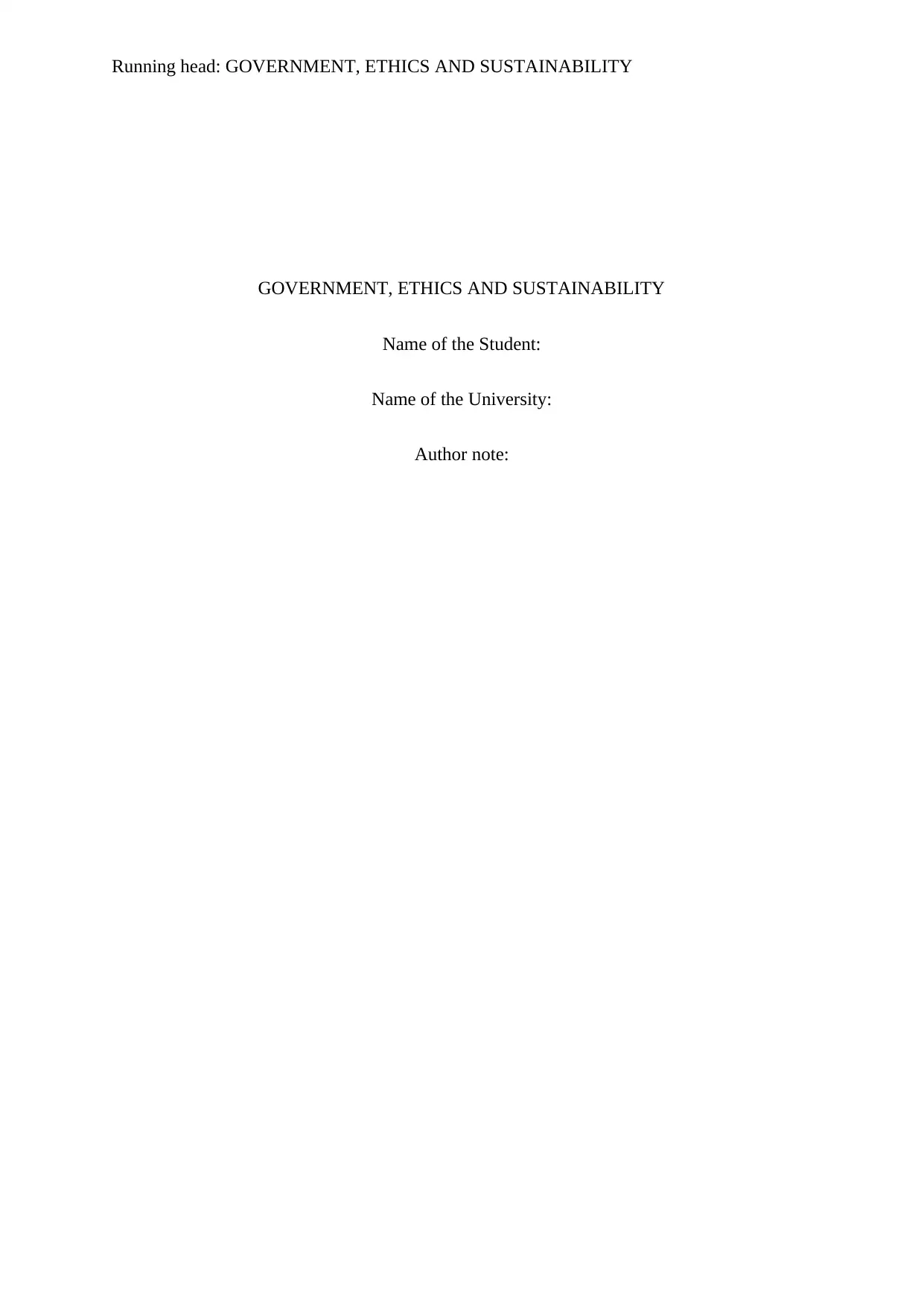
Running head: GOVERNMENT, ETHICS AND SUSTAINABILITY
GOVERNMENT, ETHICS AND SUSTAINABILITY
Name of the Student:
Name of the University:
Author note:
GOVERNMENT, ETHICS AND SUSTAINABILITY
Name of the Student:
Name of the University:
Author note:
Paraphrase This Document
Need a fresh take? Get an instant paraphrase of this document with our AI Paraphraser
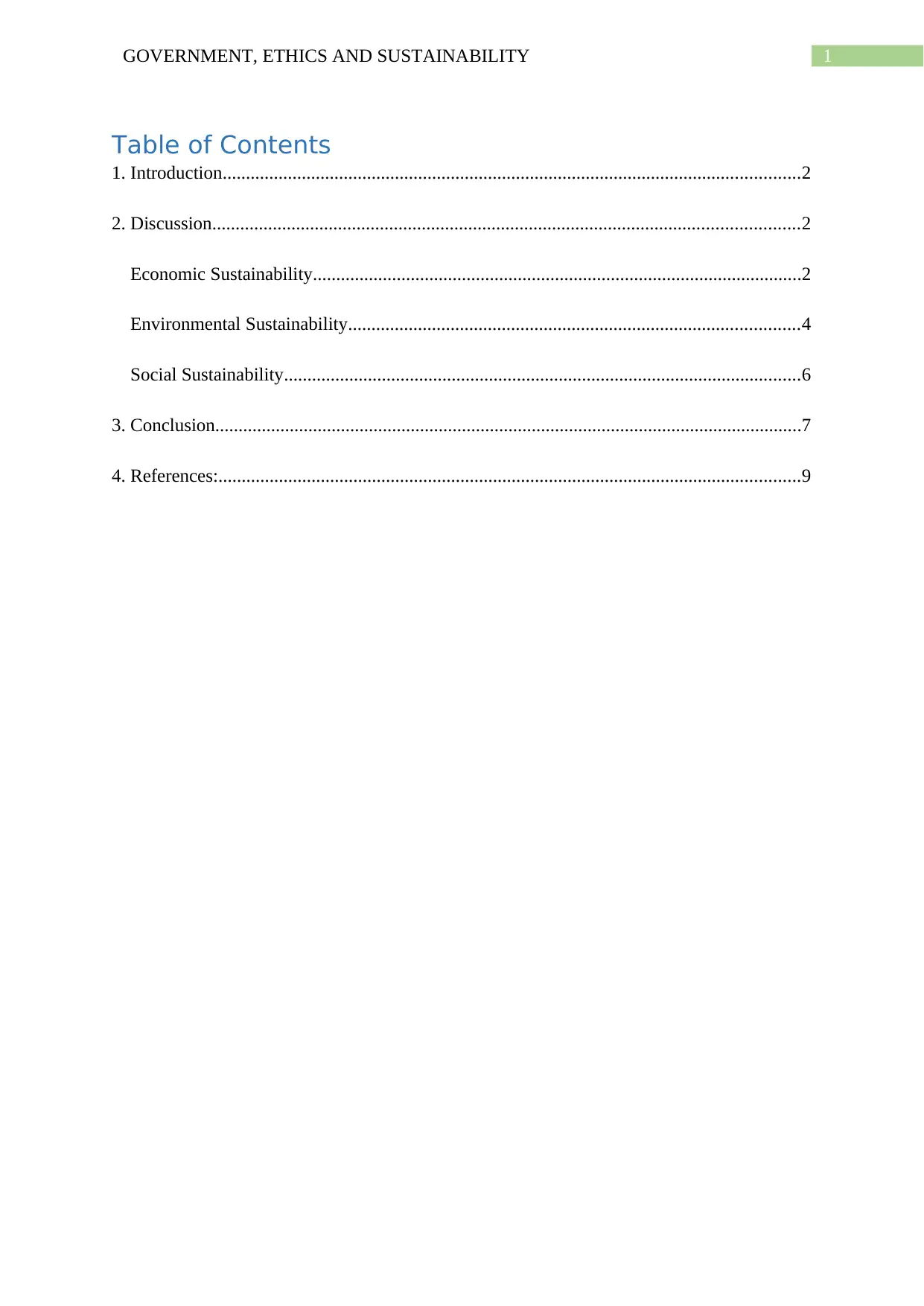
1GOVERNMENT, ETHICS AND SUSTAINABILITY
Table of Contents
1. Introduction............................................................................................................................2
2. Discussion..............................................................................................................................2
Economic Sustainability.........................................................................................................2
Environmental Sustainability.................................................................................................4
Social Sustainability...............................................................................................................6
3. Conclusion..............................................................................................................................7
4. References:.............................................................................................................................9
Table of Contents
1. Introduction............................................................................................................................2
2. Discussion..............................................................................................................................2
Economic Sustainability.........................................................................................................2
Environmental Sustainability.................................................................................................4
Social Sustainability...............................................................................................................6
3. Conclusion..............................................................................................................................7
4. References:.............................................................................................................................9
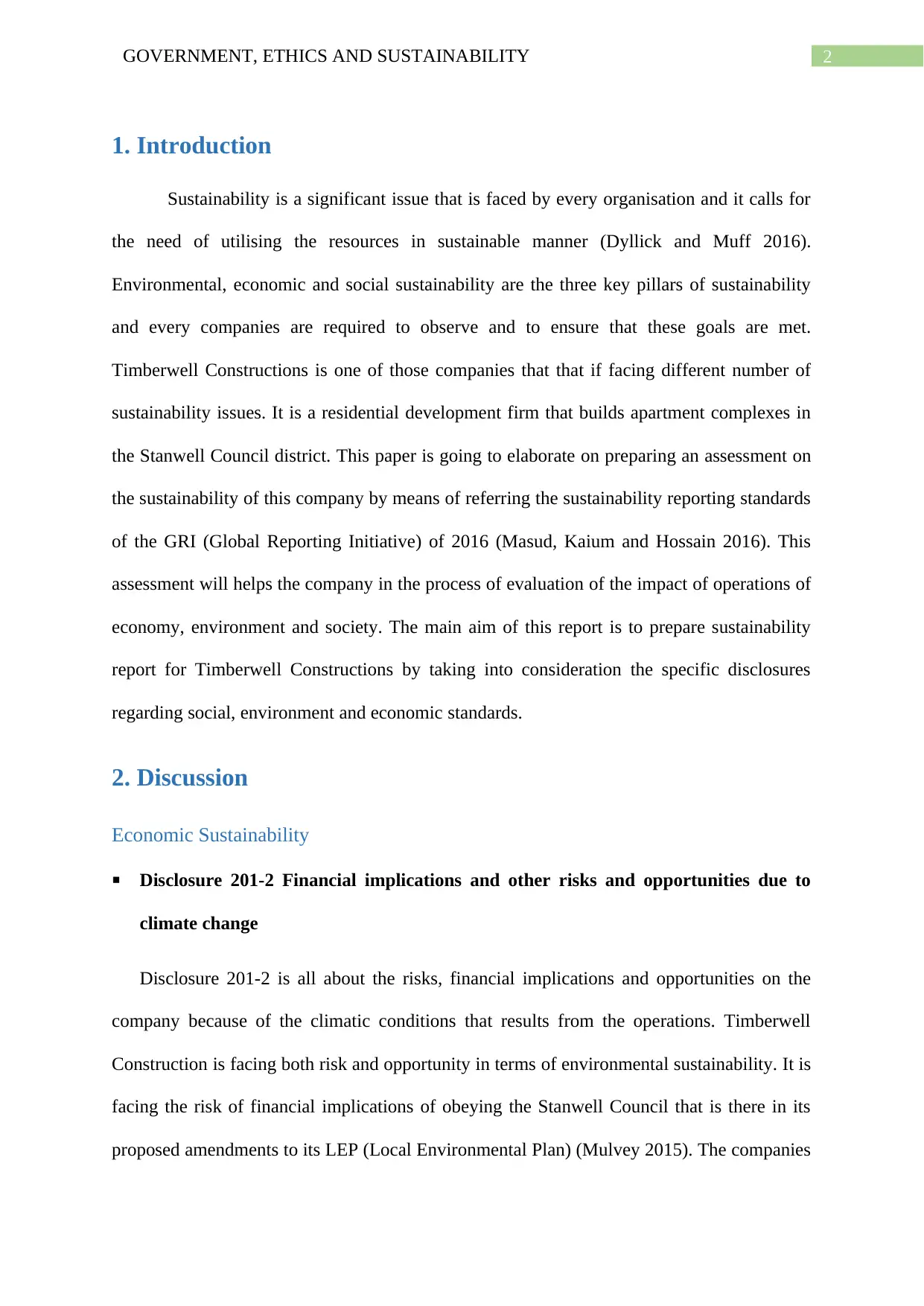
2GOVERNMENT, ETHICS AND SUSTAINABILITY
1. Introduction
Sustainability is a significant issue that is faced by every organisation and it calls for
the need of utilising the resources in sustainable manner (Dyllick and Muff 2016).
Environmental, economic and social sustainability are the three key pillars of sustainability
and every companies are required to observe and to ensure that these goals are met.
Timberwell Constructions is one of those companies that that if facing different number of
sustainability issues. It is a residential development firm that builds apartment complexes in
the Stanwell Council district. This paper is going to elaborate on preparing an assessment on
the sustainability of this company by means of referring the sustainability reporting standards
of the GRI (Global Reporting Initiative) of 2016 (Masud, Kaium and Hossain 2016). This
assessment will helps the company in the process of evaluation of the impact of operations of
economy, environment and society. The main aim of this report is to prepare sustainability
report for Timberwell Constructions by taking into consideration the specific disclosures
regarding social, environment and economic standards.
2. Discussion
Economic Sustainability
Disclosure 201-2 Financial implications and other risks and opportunities due to
climate change
Disclosure 201-2 is all about the risks, financial implications and opportunities on the
company because of the climatic conditions that results from the operations. Timberwell
Construction is facing both risk and opportunity in terms of environmental sustainability. It is
facing the risk of financial implications of obeying the Stanwell Council that is there in its
proposed amendments to its LEP (Local Environmental Plan) (Mulvey 2015). The companies
1. Introduction
Sustainability is a significant issue that is faced by every organisation and it calls for
the need of utilising the resources in sustainable manner (Dyllick and Muff 2016).
Environmental, economic and social sustainability are the three key pillars of sustainability
and every companies are required to observe and to ensure that these goals are met.
Timberwell Constructions is one of those companies that that if facing different number of
sustainability issues. It is a residential development firm that builds apartment complexes in
the Stanwell Council district. This paper is going to elaborate on preparing an assessment on
the sustainability of this company by means of referring the sustainability reporting standards
of the GRI (Global Reporting Initiative) of 2016 (Masud, Kaium and Hossain 2016). This
assessment will helps the company in the process of evaluation of the impact of operations of
economy, environment and society. The main aim of this report is to prepare sustainability
report for Timberwell Constructions by taking into consideration the specific disclosures
regarding social, environment and economic standards.
2. Discussion
Economic Sustainability
Disclosure 201-2 Financial implications and other risks and opportunities due to
climate change
Disclosure 201-2 is all about the risks, financial implications and opportunities on the
company because of the climatic conditions that results from the operations. Timberwell
Construction is facing both risk and opportunity in terms of environmental sustainability. It is
facing the risk of financial implications of obeying the Stanwell Council that is there in its
proposed amendments to its LEP (Local Environmental Plan) (Mulvey 2015). The companies
⊘ This is a preview!⊘
Do you want full access?
Subscribe today to unlock all pages.

Trusted by 1+ million students worldwide
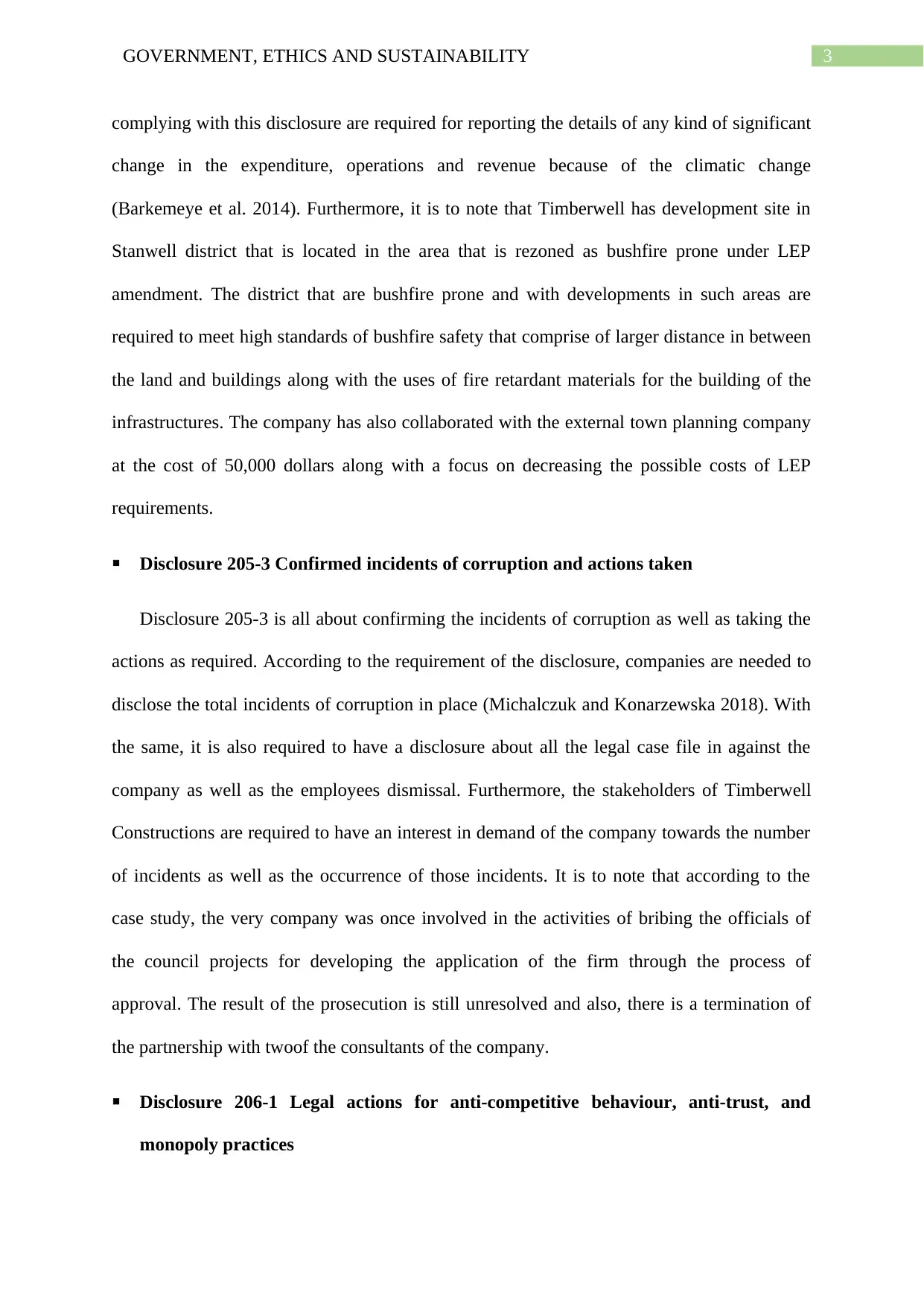
3GOVERNMENT, ETHICS AND SUSTAINABILITY
complying with this disclosure are required for reporting the details of any kind of significant
change in the expenditure, operations and revenue because of the climatic change
(Barkemeye et al. 2014). Furthermore, it is to note that Timberwell has development site in
Stanwell district that is located in the area that is rezoned as bushfire prone under LEP
amendment. The district that are bushfire prone and with developments in such areas are
required to meet high standards of bushfire safety that comprise of larger distance in between
the land and buildings along with the uses of fire retardant materials for the building of the
infrastructures. The company has also collaborated with the external town planning company
at the cost of 50,000 dollars along with a focus on decreasing the possible costs of LEP
requirements.
Disclosure 205-3 Confirmed incidents of corruption and actions taken
Disclosure 205-3 is all about confirming the incidents of corruption as well as taking the
actions as required. According to the requirement of the disclosure, companies are needed to
disclose the total incidents of corruption in place (Michalczuk and Konarzewska 2018). With
the same, it is also required to have a disclosure about all the legal case file in against the
company as well as the employees dismissal. Furthermore, the stakeholders of Timberwell
Constructions are required to have an interest in demand of the company towards the number
of incidents as well as the occurrence of those incidents. It is to note that according to the
case study, the very company was once involved in the activities of bribing the officials of
the council projects for developing the application of the firm through the process of
approval. The result of the prosecution is still unresolved and also, there is a termination of
the partnership with twoof the consultants of the company.
Disclosure 206-1 Legal actions for anti-competitive behaviour, anti-trust, and
monopoly practices
complying with this disclosure are required for reporting the details of any kind of significant
change in the expenditure, operations and revenue because of the climatic change
(Barkemeye et al. 2014). Furthermore, it is to note that Timberwell has development site in
Stanwell district that is located in the area that is rezoned as bushfire prone under LEP
amendment. The district that are bushfire prone and with developments in such areas are
required to meet high standards of bushfire safety that comprise of larger distance in between
the land and buildings along with the uses of fire retardant materials for the building of the
infrastructures. The company has also collaborated with the external town planning company
at the cost of 50,000 dollars along with a focus on decreasing the possible costs of LEP
requirements.
Disclosure 205-3 Confirmed incidents of corruption and actions taken
Disclosure 205-3 is all about confirming the incidents of corruption as well as taking the
actions as required. According to the requirement of the disclosure, companies are needed to
disclose the total incidents of corruption in place (Michalczuk and Konarzewska 2018). With
the same, it is also required to have a disclosure about all the legal case file in against the
company as well as the employees dismissal. Furthermore, the stakeholders of Timberwell
Constructions are required to have an interest in demand of the company towards the number
of incidents as well as the occurrence of those incidents. It is to note that according to the
case study, the very company was once involved in the activities of bribing the officials of
the council projects for developing the application of the firm through the process of
approval. The result of the prosecution is still unresolved and also, there is a termination of
the partnership with twoof the consultants of the company.
Disclosure 206-1 Legal actions for anti-competitive behaviour, anti-trust, and
monopoly practices
Paraphrase This Document
Need a fresh take? Get an instant paraphrase of this document with our AI Paraphraser
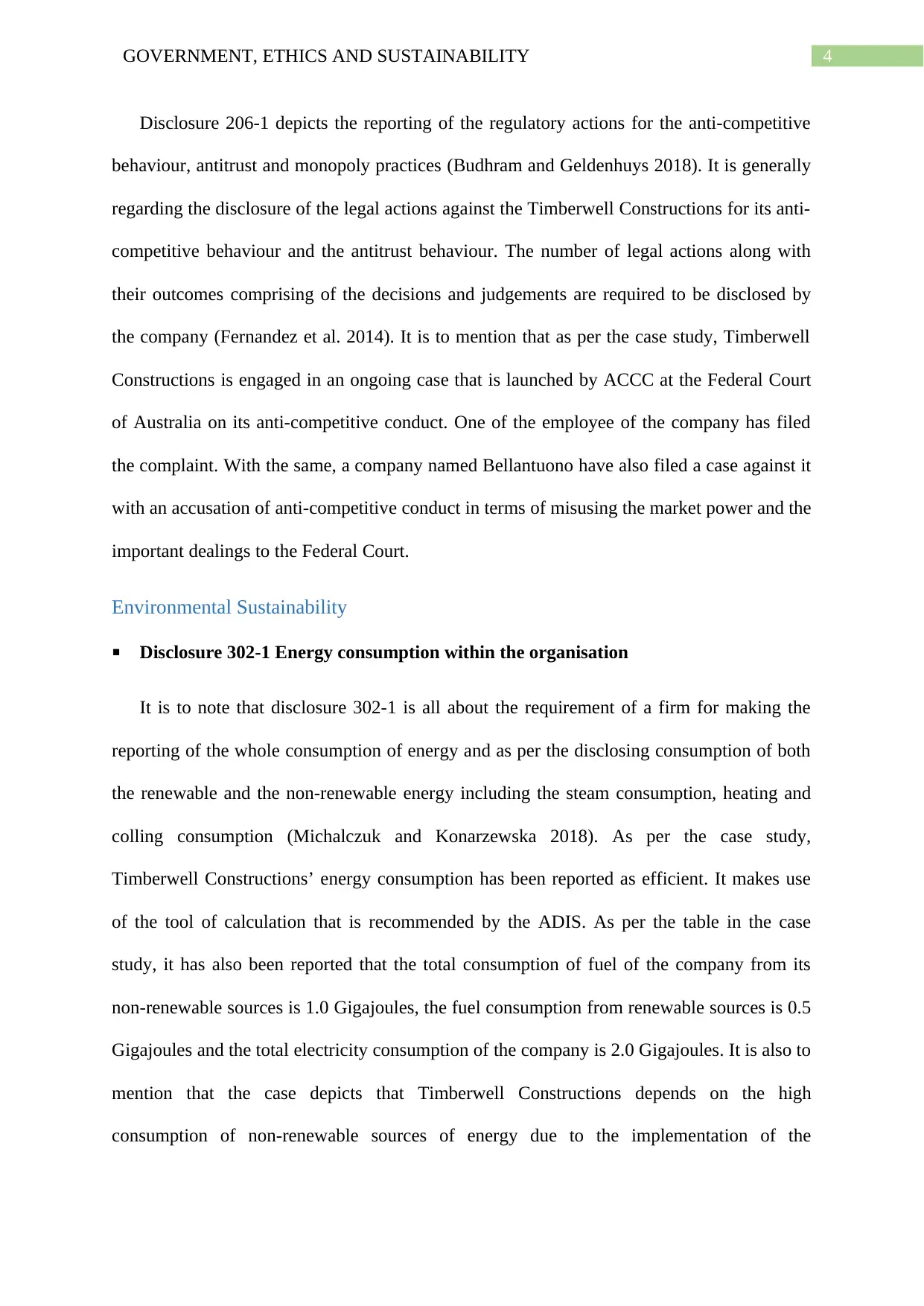
4GOVERNMENT, ETHICS AND SUSTAINABILITY
Disclosure 206-1 depicts the reporting of the regulatory actions for the anti-competitive
behaviour, antitrust and monopoly practices (Budhram and Geldenhuys 2018). It is generally
regarding the disclosure of the legal actions against the Timberwell Constructions for its anti-
competitive behaviour and the antitrust behaviour. The number of legal actions along with
their outcomes comprising of the decisions and judgements are required to be disclosed by
the company (Fernandez et al. 2014). It is to mention that as per the case study, Timberwell
Constructions is engaged in an ongoing case that is launched by ACCC at the Federal Court
of Australia on its anti-competitive conduct. One of the employee of the company has filed
the complaint. With the same, a company named Bellantuono have also filed a case against it
with an accusation of anti-competitive conduct in terms of misusing the market power and the
important dealings to the Federal Court.
Environmental Sustainability
Disclosure 302-1 Energy consumption within the organisation
It is to note that disclosure 302-1 is all about the requirement of a firm for making the
reporting of the whole consumption of energy and as per the disclosing consumption of both
the renewable and the non-renewable energy including the steam consumption, heating and
colling consumption (Michalczuk and Konarzewska 2018). As per the case study,
Timberwell Constructions’ energy consumption has been reported as efficient. It makes use
of the tool of calculation that is recommended by the ADIS. As per the table in the case
study, it has also been reported that the total consumption of fuel of the company from its
non-renewable sources is 1.0 Gigajoules, the fuel consumption from renewable sources is 0.5
Gigajoules and the total electricity consumption of the company is 2.0 Gigajoules. It is also to
mention that the case depicts that Timberwell Constructions depends on the high
consumption of non-renewable sources of energy due to the implementation of the
Disclosure 206-1 depicts the reporting of the regulatory actions for the anti-competitive
behaviour, antitrust and monopoly practices (Budhram and Geldenhuys 2018). It is generally
regarding the disclosure of the legal actions against the Timberwell Constructions for its anti-
competitive behaviour and the antitrust behaviour. The number of legal actions along with
their outcomes comprising of the decisions and judgements are required to be disclosed by
the company (Fernandez et al. 2014). It is to mention that as per the case study, Timberwell
Constructions is engaged in an ongoing case that is launched by ACCC at the Federal Court
of Australia on its anti-competitive conduct. One of the employee of the company has filed
the complaint. With the same, a company named Bellantuono have also filed a case against it
with an accusation of anti-competitive conduct in terms of misusing the market power and the
important dealings to the Federal Court.
Environmental Sustainability
Disclosure 302-1 Energy consumption within the organisation
It is to note that disclosure 302-1 is all about the requirement of a firm for making the
reporting of the whole consumption of energy and as per the disclosing consumption of both
the renewable and the non-renewable energy including the steam consumption, heating and
colling consumption (Michalczuk and Konarzewska 2018). As per the case study,
Timberwell Constructions’ energy consumption has been reported as efficient. It makes use
of the tool of calculation that is recommended by the ADIS. As per the table in the case
study, it has also been reported that the total consumption of fuel of the company from its
non-renewable sources is 1.0 Gigajoules, the fuel consumption from renewable sources is 0.5
Gigajoules and the total electricity consumption of the company is 2.0 Gigajoules. It is also to
mention that the case depicts that Timberwell Constructions depends on the high
consumption of non-renewable sources of energy due to the implementation of the
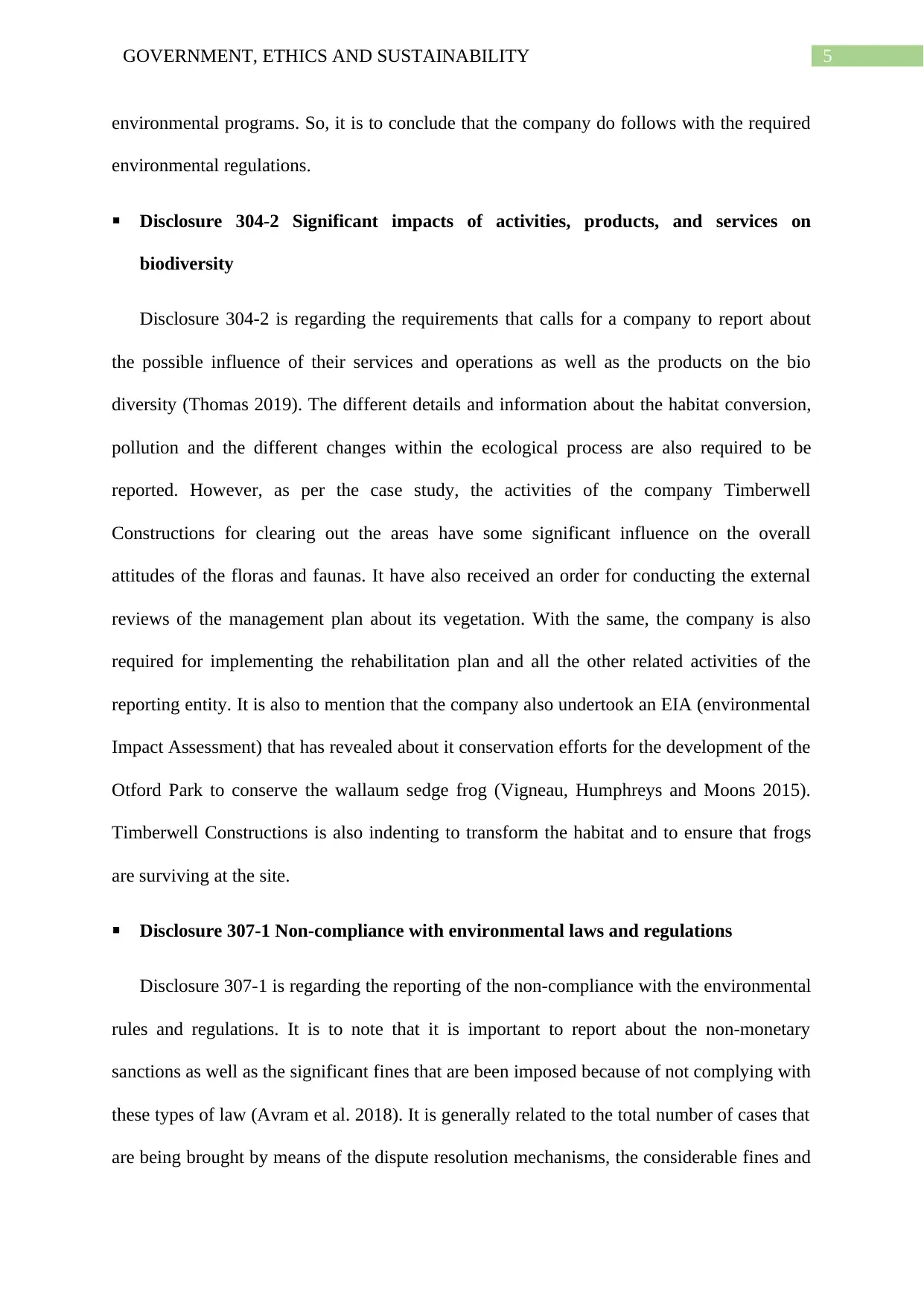
5GOVERNMENT, ETHICS AND SUSTAINABILITY
environmental programs. So, it is to conclude that the company do follows with the required
environmental regulations.
Disclosure 304-2 Significant impacts of activities, products, and services on
biodiversity
Disclosure 304-2 is regarding the requirements that calls for a company to report about
the possible influence of their services and operations as well as the products on the bio
diversity (Thomas 2019). The different details and information about the habitat conversion,
pollution and the different changes within the ecological process are also required to be
reported. However, as per the case study, the activities of the company Timberwell
Constructions for clearing out the areas have some significant influence on the overall
attitudes of the floras and faunas. It have also received an order for conducting the external
reviews of the management plan about its vegetation. With the same, the company is also
required for implementing the rehabilitation plan and all the other related activities of the
reporting entity. It is also to mention that the company also undertook an EIA (environmental
Impact Assessment) that has revealed about it conservation efforts for the development of the
Otford Park to conserve the wallaum sedge frog (Vigneau, Humphreys and Moons 2015).
Timberwell Constructions is also indenting to transform the habitat and to ensure that frogs
are surviving at the site.
Disclosure 307-1 Non-compliance with environmental laws and regulations
Disclosure 307-1 is regarding the reporting of the non-compliance with the environmental
rules and regulations. It is to note that it is important to report about the non-monetary
sanctions as well as the significant fines that are been imposed because of not complying with
these types of law (Avram et al. 2018). It is generally related to the total number of cases that
are being brought by means of the dispute resolution mechanisms, the considerable fines and
environmental programs. So, it is to conclude that the company do follows with the required
environmental regulations.
Disclosure 304-2 Significant impacts of activities, products, and services on
biodiversity
Disclosure 304-2 is regarding the requirements that calls for a company to report about
the possible influence of their services and operations as well as the products on the bio
diversity (Thomas 2019). The different details and information about the habitat conversion,
pollution and the different changes within the ecological process are also required to be
reported. However, as per the case study, the activities of the company Timberwell
Constructions for clearing out the areas have some significant influence on the overall
attitudes of the floras and faunas. It have also received an order for conducting the external
reviews of the management plan about its vegetation. With the same, the company is also
required for implementing the rehabilitation plan and all the other related activities of the
reporting entity. It is also to mention that the company also undertook an EIA (environmental
Impact Assessment) that has revealed about it conservation efforts for the development of the
Otford Park to conserve the wallaum sedge frog (Vigneau, Humphreys and Moons 2015).
Timberwell Constructions is also indenting to transform the habitat and to ensure that frogs
are surviving at the site.
Disclosure 307-1 Non-compliance with environmental laws and regulations
Disclosure 307-1 is regarding the reporting of the non-compliance with the environmental
rules and regulations. It is to note that it is important to report about the non-monetary
sanctions as well as the significant fines that are been imposed because of not complying with
these types of law (Avram et al. 2018). It is generally related to the total number of cases that
are being brought by means of the dispute resolution mechanisms, the considerable fines and
⊘ This is a preview!⊘
Do you want full access?
Subscribe today to unlock all pages.

Trusted by 1+ million students worldwide
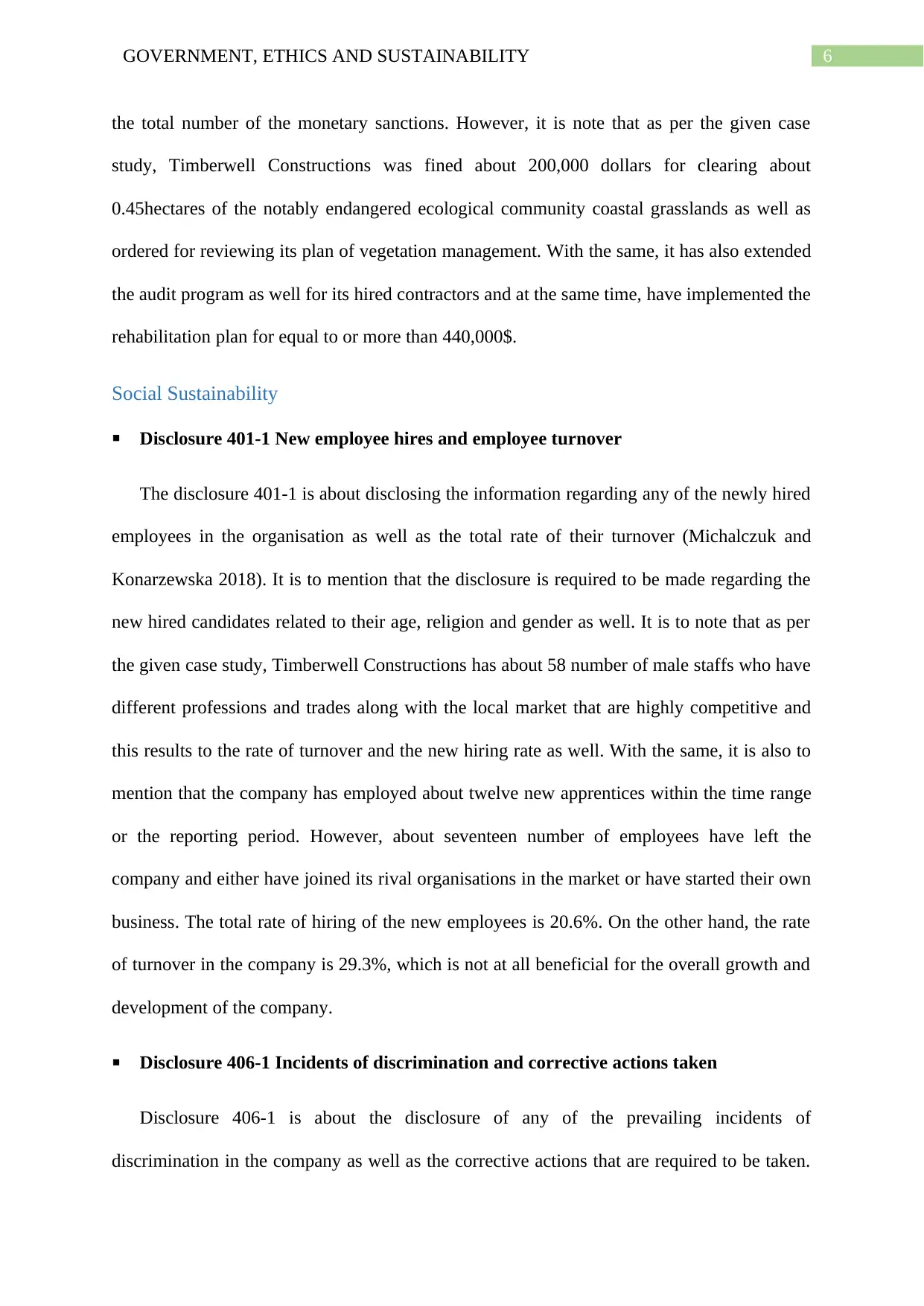
6GOVERNMENT, ETHICS AND SUSTAINABILITY
the total number of the monetary sanctions. However, it is note that as per the given case
study, Timberwell Constructions was fined about 200,000 dollars for clearing about
0.45hectares of the notably endangered ecological community coastal grasslands as well as
ordered for reviewing its plan of vegetation management. With the same, it has also extended
the audit program as well for its hired contractors and at the same time, have implemented the
rehabilitation plan for equal to or more than 440,000$.
Social Sustainability
Disclosure 401-1 New employee hires and employee turnover
The disclosure 401-1 is about disclosing the information regarding any of the newly hired
employees in the organisation as well as the total rate of their turnover (Michalczuk and
Konarzewska 2018). It is to mention that the disclosure is required to be made regarding the
new hired candidates related to their age, religion and gender as well. It is to note that as per
the given case study, Timberwell Constructions has about 58 number of male staffs who have
different professions and trades along with the local market that are highly competitive and
this results to the rate of turnover and the new hiring rate as well. With the same, it is also to
mention that the company has employed about twelve new apprentices within the time range
or the reporting period. However, about seventeen number of employees have left the
company and either have joined its rival organisations in the market or have started their own
business. The total rate of hiring of the new employees is 20.6%. On the other hand, the rate
of turnover in the company is 29.3%, which is not at all beneficial for the overall growth and
development of the company.
Disclosure 406-1 Incidents of discrimination and corrective actions taken
Disclosure 406-1 is about the disclosure of any of the prevailing incidents of
discrimination in the company as well as the corrective actions that are required to be taken.
the total number of the monetary sanctions. However, it is note that as per the given case
study, Timberwell Constructions was fined about 200,000 dollars for clearing about
0.45hectares of the notably endangered ecological community coastal grasslands as well as
ordered for reviewing its plan of vegetation management. With the same, it has also extended
the audit program as well for its hired contractors and at the same time, have implemented the
rehabilitation plan for equal to or more than 440,000$.
Social Sustainability
Disclosure 401-1 New employee hires and employee turnover
The disclosure 401-1 is about disclosing the information regarding any of the newly hired
employees in the organisation as well as the total rate of their turnover (Michalczuk and
Konarzewska 2018). It is to mention that the disclosure is required to be made regarding the
new hired candidates related to their age, religion and gender as well. It is to note that as per
the given case study, Timberwell Constructions has about 58 number of male staffs who have
different professions and trades along with the local market that are highly competitive and
this results to the rate of turnover and the new hiring rate as well. With the same, it is also to
mention that the company has employed about twelve new apprentices within the time range
or the reporting period. However, about seventeen number of employees have left the
company and either have joined its rival organisations in the market or have started their own
business. The total rate of hiring of the new employees is 20.6%. On the other hand, the rate
of turnover in the company is 29.3%, which is not at all beneficial for the overall growth and
development of the company.
Disclosure 406-1 Incidents of discrimination and corrective actions taken
Disclosure 406-1 is about the disclosure of any of the prevailing incidents of
discrimination in the company as well as the corrective actions that are required to be taken.
Paraphrase This Document
Need a fresh take? Get an instant paraphrase of this document with our AI Paraphraser
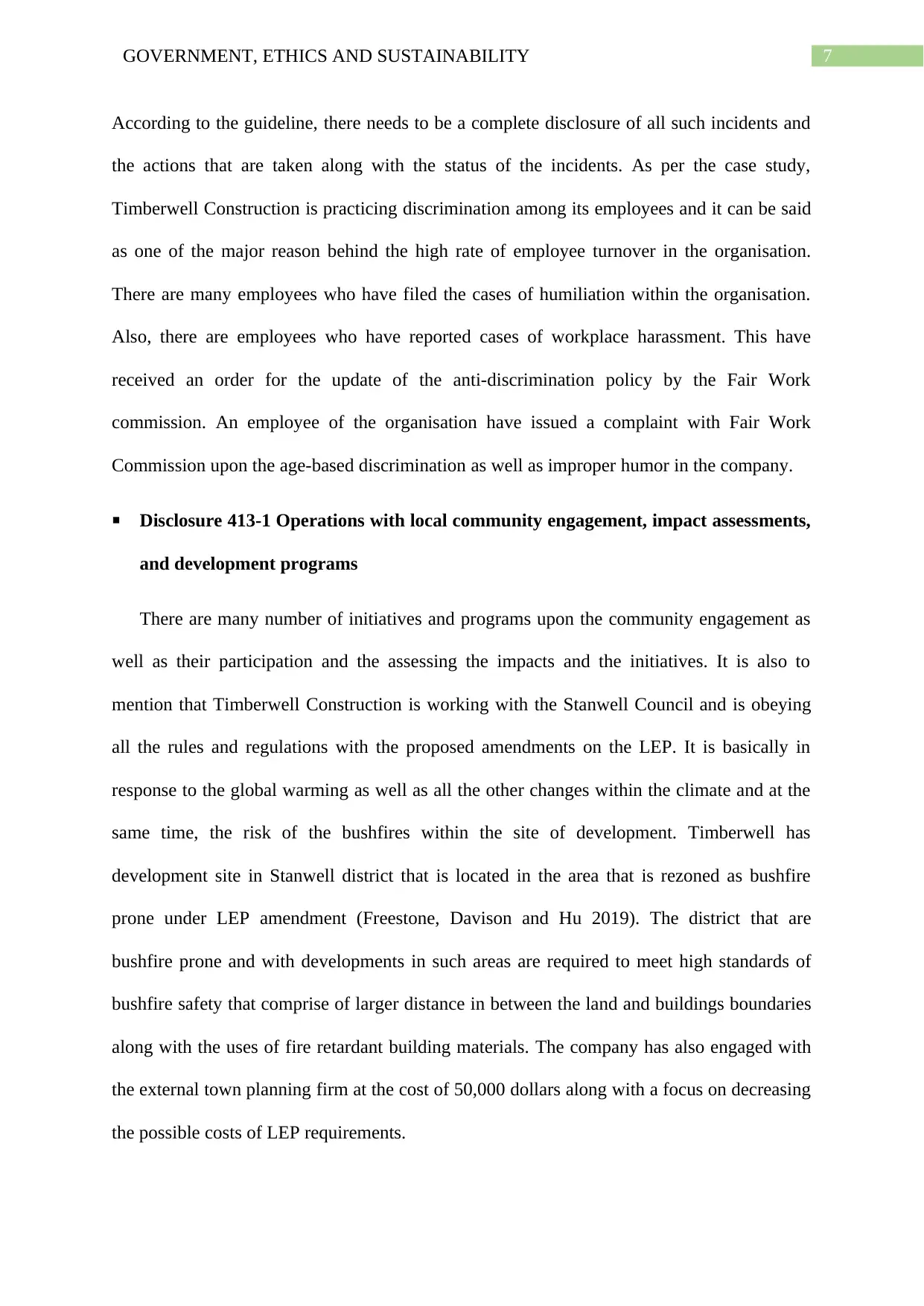
7GOVERNMENT, ETHICS AND SUSTAINABILITY
According to the guideline, there needs to be a complete disclosure of all such incidents and
the actions that are taken along with the status of the incidents. As per the case study,
Timberwell Construction is practicing discrimination among its employees and it can be said
as one of the major reason behind the high rate of employee turnover in the organisation.
There are many employees who have filed the cases of humiliation within the organisation.
Also, there are employees who have reported cases of workplace harassment. This have
received an order for the update of the anti-discrimination policy by the Fair Work
commission. An employee of the organisation have issued a complaint with Fair Work
Commission upon the age-based discrimination as well as improper humor in the company.
Disclosure 413-1 Operations with local community engagement, impact assessments,
and development programs
There are many number of initiatives and programs upon the community engagement as
well as their participation and the assessing the impacts and the initiatives. It is also to
mention that Timberwell Construction is working with the Stanwell Council and is obeying
all the rules and regulations with the proposed amendments on the LEP. It is basically in
response to the global warming as well as all the other changes within the climate and at the
same time, the risk of the bushfires within the site of development. Timberwell has
development site in Stanwell district that is located in the area that is rezoned as bushfire
prone under LEP amendment (Freestone, Davison and Hu 2019). The district that are
bushfire prone and with developments in such areas are required to meet high standards of
bushfire safety that comprise of larger distance in between the land and buildings boundaries
along with the uses of fire retardant building materials. The company has also engaged with
the external town planning firm at the cost of 50,000 dollars along with a focus on decreasing
the possible costs of LEP requirements.
According to the guideline, there needs to be a complete disclosure of all such incidents and
the actions that are taken along with the status of the incidents. As per the case study,
Timberwell Construction is practicing discrimination among its employees and it can be said
as one of the major reason behind the high rate of employee turnover in the organisation.
There are many employees who have filed the cases of humiliation within the organisation.
Also, there are employees who have reported cases of workplace harassment. This have
received an order for the update of the anti-discrimination policy by the Fair Work
commission. An employee of the organisation have issued a complaint with Fair Work
Commission upon the age-based discrimination as well as improper humor in the company.
Disclosure 413-1 Operations with local community engagement, impact assessments,
and development programs
There are many number of initiatives and programs upon the community engagement as
well as their participation and the assessing the impacts and the initiatives. It is also to
mention that Timberwell Construction is working with the Stanwell Council and is obeying
all the rules and regulations with the proposed amendments on the LEP. It is basically in
response to the global warming as well as all the other changes within the climate and at the
same time, the risk of the bushfires within the site of development. Timberwell has
development site in Stanwell district that is located in the area that is rezoned as bushfire
prone under LEP amendment (Freestone, Davison and Hu 2019). The district that are
bushfire prone and with developments in such areas are required to meet high standards of
bushfire safety that comprise of larger distance in between the land and buildings boundaries
along with the uses of fire retardant building materials. The company has also engaged with
the external town planning firm at the cost of 50,000 dollars along with a focus on decreasing
the possible costs of LEP requirements.
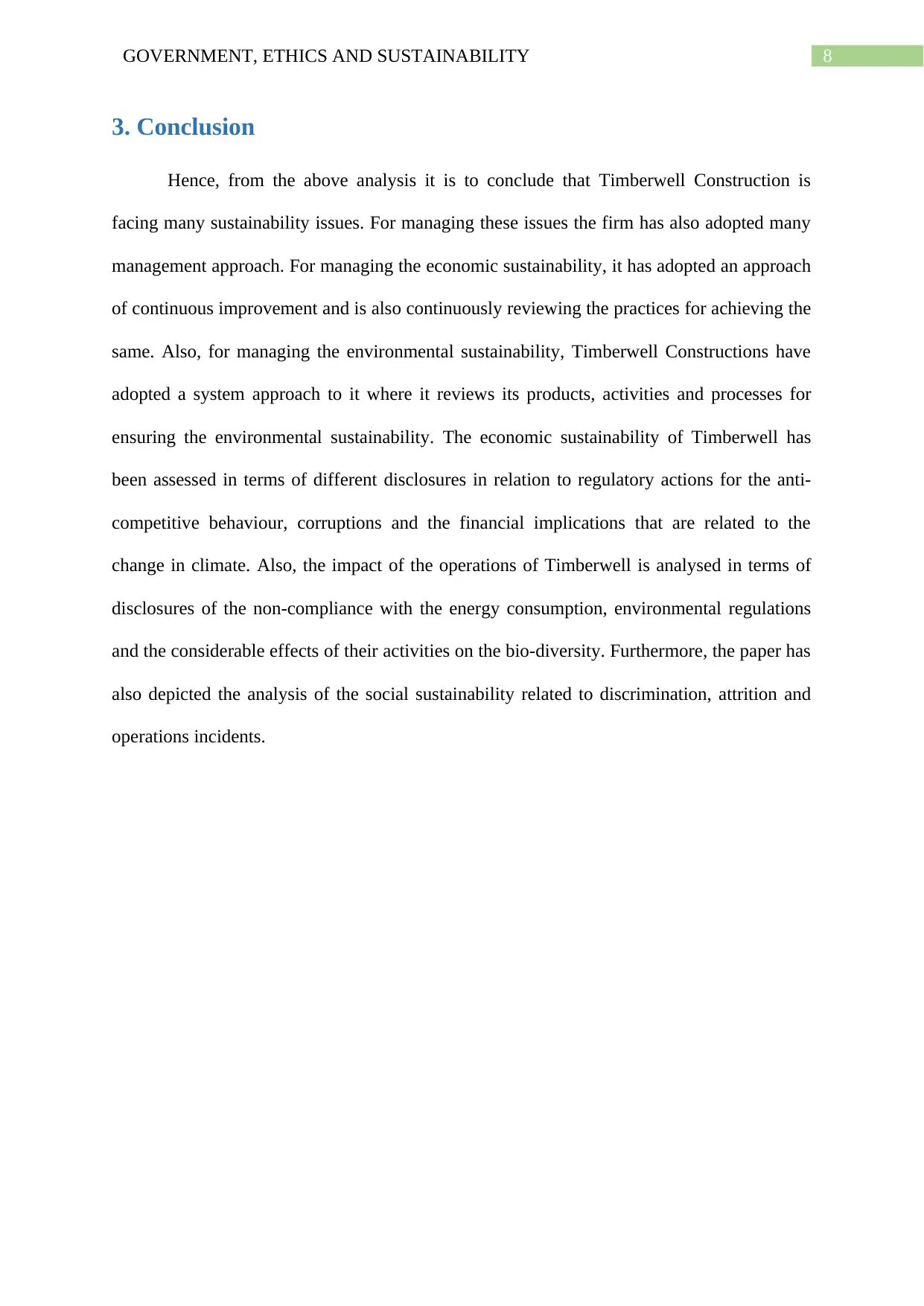
8GOVERNMENT, ETHICS AND SUSTAINABILITY
3. Conclusion
Hence, from the above analysis it is to conclude that Timberwell Construction is
facing many sustainability issues. For managing these issues the firm has also adopted many
management approach. For managing the economic sustainability, it has adopted an approach
of continuous improvement and is also continuously reviewing the practices for achieving the
same. Also, for managing the environmental sustainability, Timberwell Constructions have
adopted a system approach to it where it reviews its products, activities and processes for
ensuring the environmental sustainability. The economic sustainability of Timberwell has
been assessed in terms of different disclosures in relation to regulatory actions for the anti-
competitive behaviour, corruptions and the financial implications that are related to the
change in climate. Also, the impact of the operations of Timberwell is analysed in terms of
disclosures of the non-compliance with the energy consumption, environmental regulations
and the considerable effects of their activities on the bio-diversity. Furthermore, the paper has
also depicted the analysis of the social sustainability related to discrimination, attrition and
operations incidents.
3. Conclusion
Hence, from the above analysis it is to conclude that Timberwell Construction is
facing many sustainability issues. For managing these issues the firm has also adopted many
management approach. For managing the economic sustainability, it has adopted an approach
of continuous improvement and is also continuously reviewing the practices for achieving the
same. Also, for managing the environmental sustainability, Timberwell Constructions have
adopted a system approach to it where it reviews its products, activities and processes for
ensuring the environmental sustainability. The economic sustainability of Timberwell has
been assessed in terms of different disclosures in relation to regulatory actions for the anti-
competitive behaviour, corruptions and the financial implications that are related to the
change in climate. Also, the impact of the operations of Timberwell is analysed in terms of
disclosures of the non-compliance with the energy consumption, environmental regulations
and the considerable effects of their activities on the bio-diversity. Furthermore, the paper has
also depicted the analysis of the social sustainability related to discrimination, attrition and
operations incidents.
⊘ This is a preview!⊘
Do you want full access?
Subscribe today to unlock all pages.

Trusted by 1+ million students worldwide
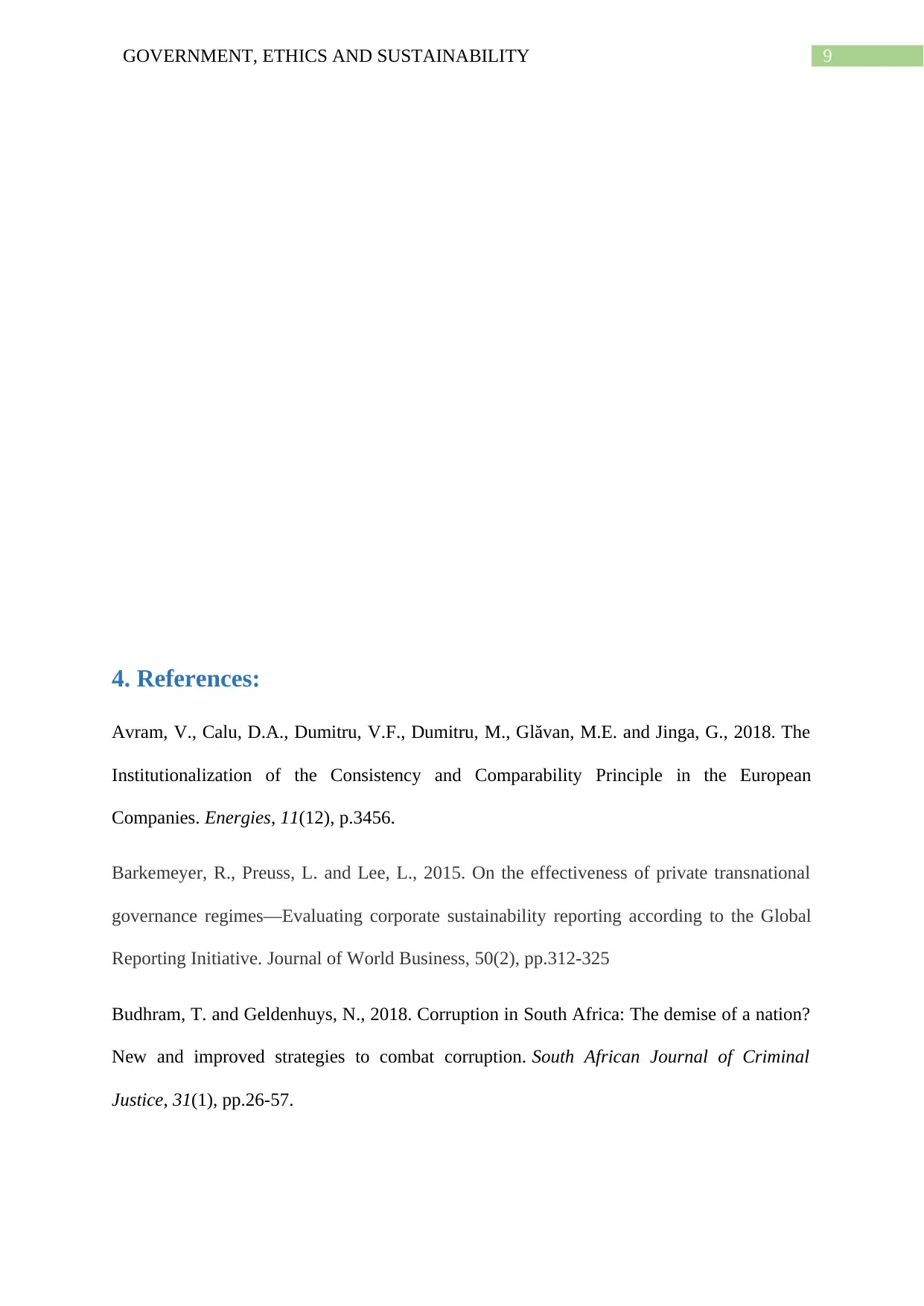
9GOVERNMENT, ETHICS AND SUSTAINABILITY
4. References:
Avram, V., Calu, D.A., Dumitru, V.F., Dumitru, M., Glăvan, M.E. and Jinga, G., 2018. The
Institutionalization of the Consistency and Comparability Principle in the European
Companies. Energies, 11(12), p.3456.
Barkemeyer, R., Preuss, L. and Lee, L., 2015. On the effectiveness of private transnational
governance regimes—Evaluating corporate sustainability reporting according to the Global
Reporting Initiative. Journal of World Business, 50(2), pp.312-325
Budhram, T. and Geldenhuys, N., 2018. Corruption in South Africa: The demise of a nation?
New and improved strategies to combat corruption. South African Journal of Criminal
Justice, 31(1), pp.26-57.
4. References:
Avram, V., Calu, D.A., Dumitru, V.F., Dumitru, M., Glăvan, M.E. and Jinga, G., 2018. The
Institutionalization of the Consistency and Comparability Principle in the European
Companies. Energies, 11(12), p.3456.
Barkemeyer, R., Preuss, L. and Lee, L., 2015. On the effectiveness of private transnational
governance regimes—Evaluating corporate sustainability reporting according to the Global
Reporting Initiative. Journal of World Business, 50(2), pp.312-325
Budhram, T. and Geldenhuys, N., 2018. Corruption in South Africa: The demise of a nation?
New and improved strategies to combat corruption. South African Journal of Criminal
Justice, 31(1), pp.26-57.
Paraphrase This Document
Need a fresh take? Get an instant paraphrase of this document with our AI Paraphraser
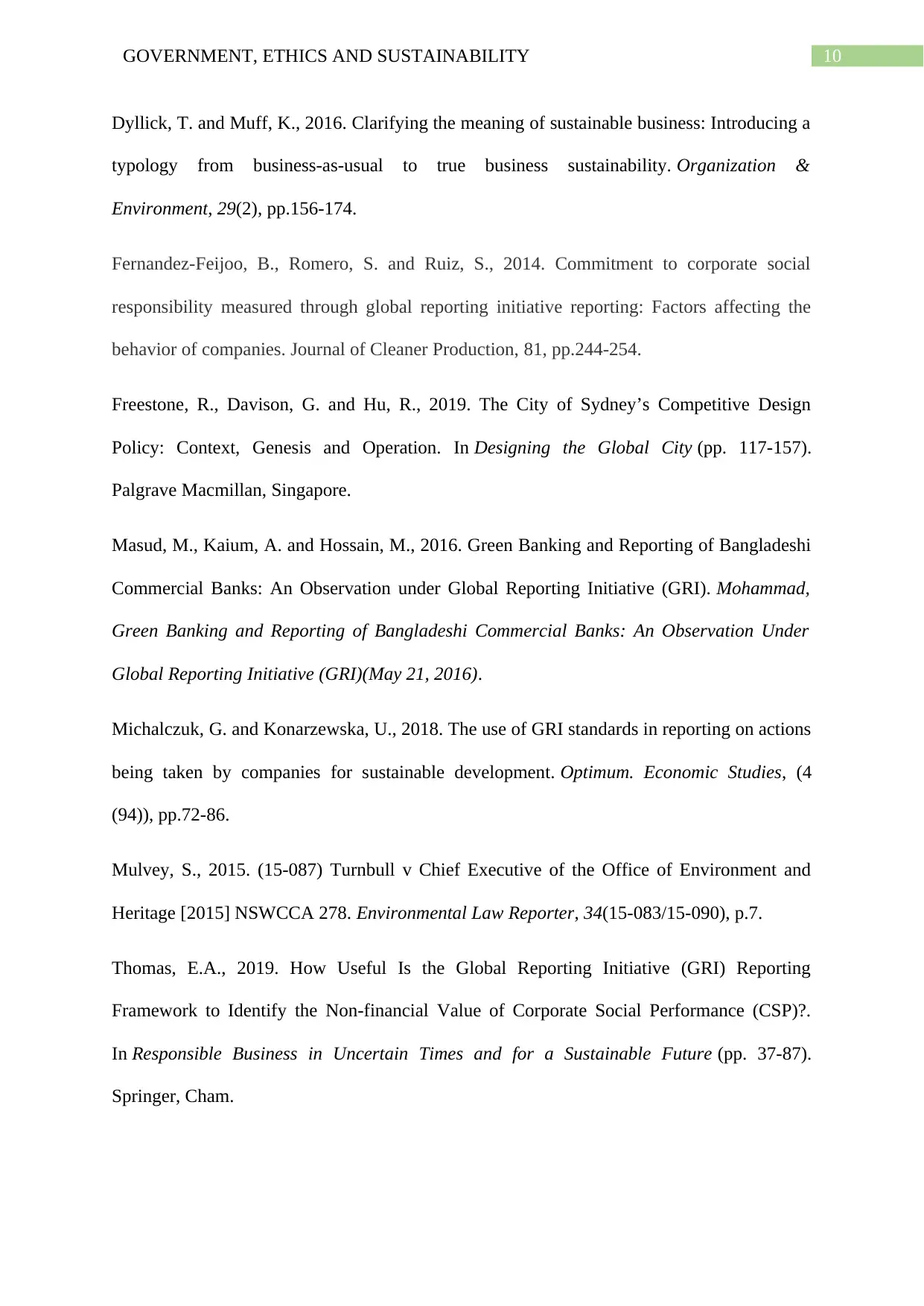
10GOVERNMENT, ETHICS AND SUSTAINABILITY
Dyllick, T. and Muff, K., 2016. Clarifying the meaning of sustainable business: Introducing a
typology from business-as-usual to true business sustainability. Organization &
Environment, 29(2), pp.156-174.
Fernandez-Feijoo, B., Romero, S. and Ruiz, S., 2014. Commitment to corporate social
responsibility measured through global reporting initiative reporting: Factors affecting the
behavior of companies. Journal of Cleaner Production, 81, pp.244-254.
Freestone, R., Davison, G. and Hu, R., 2019. The City of Sydney’s Competitive Design
Policy: Context, Genesis and Operation. In Designing the Global City (pp. 117-157).
Palgrave Macmillan, Singapore.
Masud, M., Kaium, A. and Hossain, M., 2016. Green Banking and Reporting of Bangladeshi
Commercial Banks: An Observation under Global Reporting Initiative (GRI). Mohammad,
Green Banking and Reporting of Bangladeshi Commercial Banks: An Observation Under
Global Reporting Initiative (GRI)(May 21, 2016).
Michalczuk, G. and Konarzewska, U., 2018. The use of GRI standards in reporting on actions
being taken by companies for sustainable development. Optimum. Economic Studies, (4
(94)), pp.72-86.
Mulvey, S., 2015. (15-087) Turnbull v Chief Executive of the Office of Environment and
Heritage [2015] NSWCCA 278. Environmental Law Reporter, 34(15-083/15-090), p.7.
Thomas, E.A., 2019. How Useful Is the Global Reporting Initiative (GRI) Reporting
Framework to Identify the Non-financial Value of Corporate Social Performance (CSP)?.
In Responsible Business in Uncertain Times and for a Sustainable Future (pp. 37-87).
Springer, Cham.
Dyllick, T. and Muff, K., 2016. Clarifying the meaning of sustainable business: Introducing a
typology from business-as-usual to true business sustainability. Organization &
Environment, 29(2), pp.156-174.
Fernandez-Feijoo, B., Romero, S. and Ruiz, S., 2014. Commitment to corporate social
responsibility measured through global reporting initiative reporting: Factors affecting the
behavior of companies. Journal of Cleaner Production, 81, pp.244-254.
Freestone, R., Davison, G. and Hu, R., 2019. The City of Sydney’s Competitive Design
Policy: Context, Genesis and Operation. In Designing the Global City (pp. 117-157).
Palgrave Macmillan, Singapore.
Masud, M., Kaium, A. and Hossain, M., 2016. Green Banking and Reporting of Bangladeshi
Commercial Banks: An Observation under Global Reporting Initiative (GRI). Mohammad,
Green Banking and Reporting of Bangladeshi Commercial Banks: An Observation Under
Global Reporting Initiative (GRI)(May 21, 2016).
Michalczuk, G. and Konarzewska, U., 2018. The use of GRI standards in reporting on actions
being taken by companies for sustainable development. Optimum. Economic Studies, (4
(94)), pp.72-86.
Mulvey, S., 2015. (15-087) Turnbull v Chief Executive of the Office of Environment and
Heritage [2015] NSWCCA 278. Environmental Law Reporter, 34(15-083/15-090), p.7.
Thomas, E.A., 2019. How Useful Is the Global Reporting Initiative (GRI) Reporting
Framework to Identify the Non-financial Value of Corporate Social Performance (CSP)?.
In Responsible Business in Uncertain Times and for a Sustainable Future (pp. 37-87).
Springer, Cham.
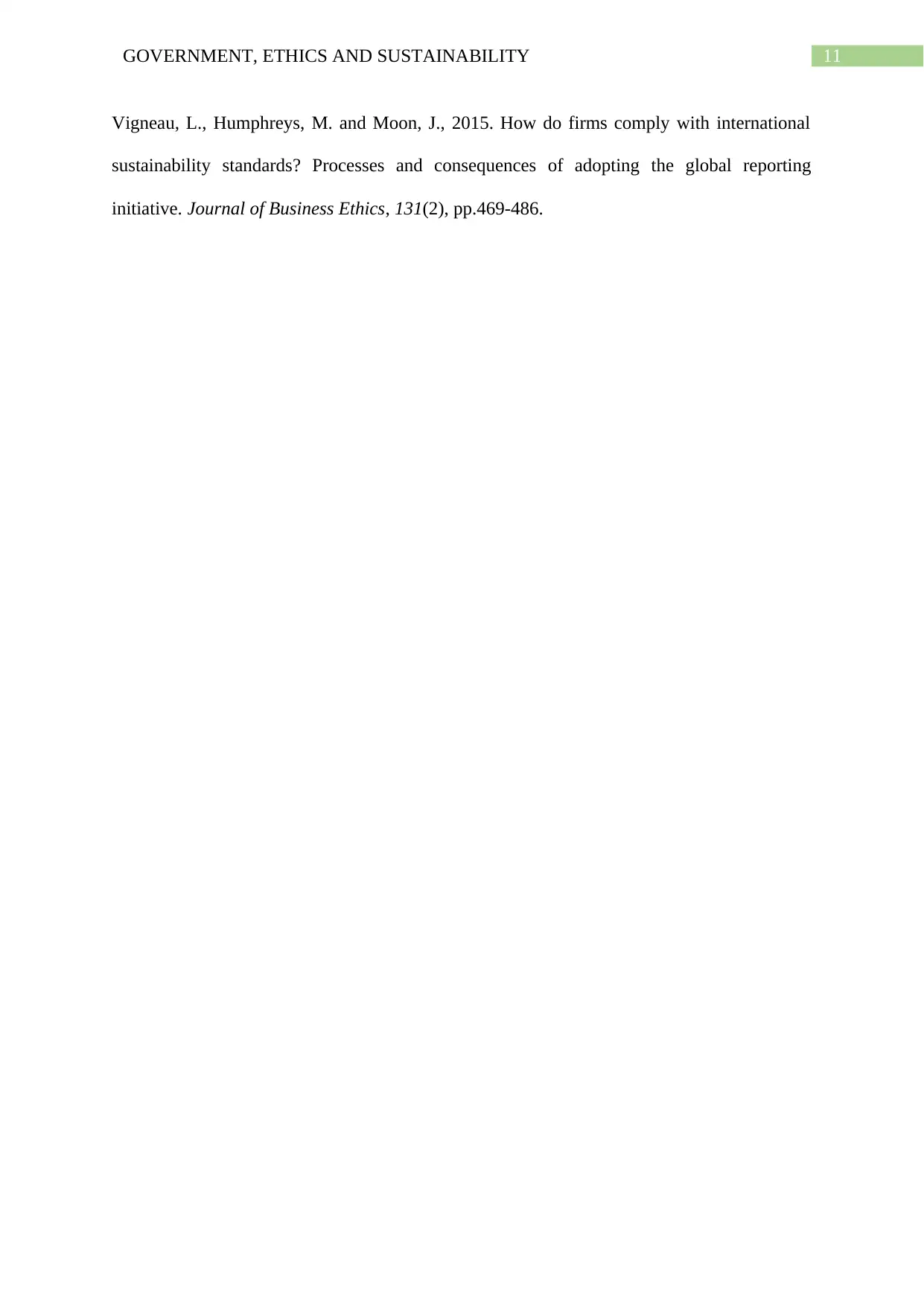
11GOVERNMENT, ETHICS AND SUSTAINABILITY
Vigneau, L., Humphreys, M. and Moon, J., 2015. How do firms comply with international
sustainability standards? Processes and consequences of adopting the global reporting
initiative. Journal of Business Ethics, 131(2), pp.469-486.
Vigneau, L., Humphreys, M. and Moon, J., 2015. How do firms comply with international
sustainability standards? Processes and consequences of adopting the global reporting
initiative. Journal of Business Ethics, 131(2), pp.469-486.
⊘ This is a preview!⊘
Do you want full access?
Subscribe today to unlock all pages.

Trusted by 1+ million students worldwide
1 out of 12
Related Documents
Your All-in-One AI-Powered Toolkit for Academic Success.
+13062052269
info@desklib.com
Available 24*7 on WhatsApp / Email
![[object Object]](/_next/static/media/star-bottom.7253800d.svg)
Unlock your academic potential
Copyright © 2020–2025 A2Z Services. All Rights Reserved. Developed and managed by ZUCOL.





